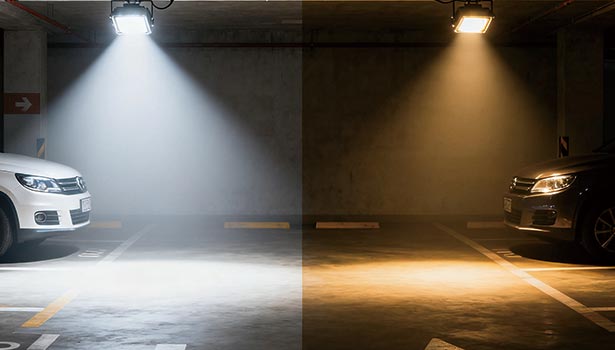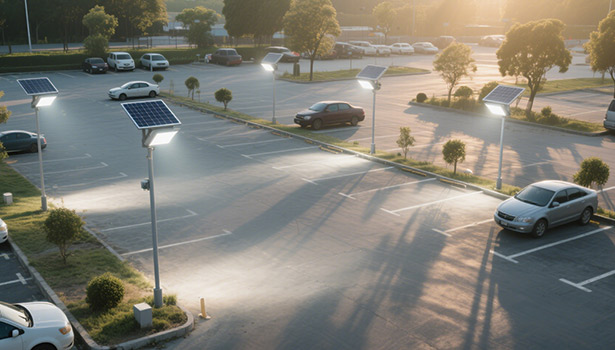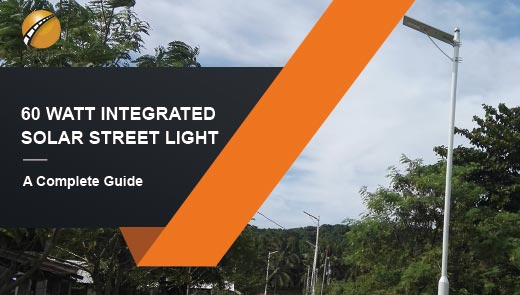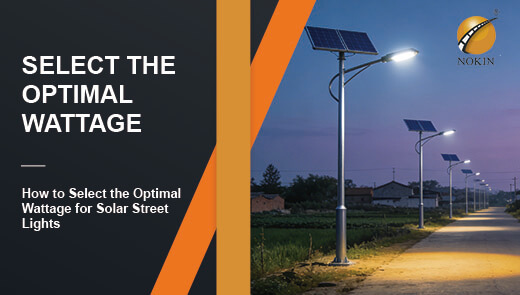The Difference Between LED Floodlights and Traditional Floodlights
Lighting plays a vital role in people's lives, whether in residential settings or commercial activities, and selecting the right fixtures is especially crucial for outdoor illumination. LED floodlights and traditional floodlights are two common choices in outdoor lighting today, each with distinct characteristics suited for different scenarios. This article will delve into the differences between LED floodlights and traditional floodlights, providing valuable insights for readers selecting outdoor lighting fixtures to help them make the best choice for their needs.

Understanding LED Flood Lights
LED flood lights are lighting fixtures powered by LED technology, capable of delivering high-intensity illumination with extensive coverage. At their core lies the use of light-emitting diodes (LED), a design that enables ample brightness without excessive power consumption.
Due to their exceptional brightness, LED flood lights are typically suited for outdoor applications. For instance, they enhance illumination in security zones, making surroundings more clearly visible. They illuminate pathways and driveways, facilitating safe passage. Additionally, they can highlight unique architectural features and garden elements, enhancing their aesthetic appeal. However, their intense brightness makes them unsuitable for indoor lighting, as it may cause discomfort.
Exploring Traditional Lighting Options
Halogen Floodlights
Halogen floodlights represent a common choice in traditional outdoor lighting. They operate by sealing a tungsten filament within a small quartz bulb filled with halogen gas. When electricity passes through the filament, it heats up and emits light, providing high-intensity illumination for outdoor spaces.
Incandescent and Fluorescent Lights
Beyond halogen floodlights, incandescent and fluorescent lights remain integral components of traditional lighting. Compared to LED floodlights, these conventional light sources exhibit significant gaps in efficiency and lifespan. They consume more energy to produce equivalent brightness and have relatively shorter lifespans, necessitating more frequent replacements.
With the continuous advancement and widespread adoption of LED technology, traditional lighting methods like halogen floodlights, incandescent bulbs, and fluorescent lights are in a clear phase of decline. Since LED floodlights far surpass traditional lighting in energy efficiency, lifespan, and durability, most people prioritize LED floodlights when selecting lighting equipment.
The Difference Between LED Floodlights and Traditional Floodlights
Energy Efficiency
LED technology boasts exceptional efficiency in converting electrical energy into light energy. This significantly reduces the energy consumption of LED floodlights, effectively lowering electricity costs. In contrast, traditional metal halide lamps are notorious for their low energy efficiency. They generate substantial heat alongside light output, resulting in significant energy waste.
Longevity
|
Lamp Type |
Lifespan |
Advantages |
|
LED Floodlight |
Over 50,000 hours |
Reduces replacement frequency, lowers maintenance costs, more economical in the long run |
|
Traditional Metal Halide Lamp |
6,000–15,000 hours |
No significant advantages |
Instant Illumination
LED floodlights provide instant illumination upon activation, requiring no warm-up time to deliver full brightness immediately. In contrast, traditional metal halide lamps take several minutes to reach full brightness. This delay not only causes inconvenience but also poses potential safety risks in emergency situations or scenarios demanding rapid lighting.
Color Rendering
LED floodlights demonstrate superior color rendering. Their technology enables customizable color temperature adjustment, ensuring illuminated areas display vivid, true-to-life colors. This feature is particularly crucial in retail and similar sectors, where accurate color presentation is vital for product display. In contrast, traditional metal halide lamps exhibit poor color rendering, struggling to faithfully reproduce object colors.
Directional Lighting
LED floodlights emit light with specific directionality, precisely illuminating target areas while minimizing light waste and spill. Traditional metal halide lamps, however, emit light omnidirectionally, leading to significant light loss and reduced illumination efficiency. This directional lighting capability makes LED floodlights highly suitable for outdoor security lighting applications, where precise light control is critical.

Environmental Impact
LED floodlights represent an eco-friendly lighting solution. They contain no harmful substances like mercury, which is commonly present in traditional metal halide lamps. Additionally, their high energy efficiency reduces carbon emissions, helping lower the carbon footprint and contributing positively to environmental protection.
Durability
LED floodlights are more durable and resilient than traditional lighting fixtures like metal halide lamps. Their design withstands harsh weather conditions, including rain, strong winds, and extreme temperatures. This exceptional durability ensures a long service life even in challenging environments.
Dimming Capability
LED floodlights offer flexible dimming functionality, allowing users to easily adjust light intensity through a compatible control system. This enables seamless transitions from soft ambient lighting to bright task illumination. This feature proves highly advantageous in diverse scenarios—for instance, nighttime security can be set to low brightness for energy-efficient monitoring, while sudden incidents can be instantly illuminated with high-intensity alert lighting. Conversely, traditional metal halide lamps, constrained by their light-emitting principles, operate at a fixed brightness. They cannot adapt to varying light requirements nor achieve additional energy savings, resulting in significantly lower adaptability across scenarios.
Cost Analysis: Upfront Cost vs. Long-Term Savings
Initial Investment in LED Flood Lights
Compared to traditional fixtures, LED flood lights incorporate newer technology, resulting in relatively higher upfront costs. However, this should not deter their adoption. Despite the higher initial price, LED flood lights offer exceptional energy efficiency and an extremely long lifespan. Over the long term, users recoup their initial investment through energy savings and reduced replacement costs, while also gaining additional benefits.
Cost of Traditional Lighting
It is widely known that traditional lighting fixtures are cheaper than LED flood lights. However, the picture changes when considering long-term usage. Traditional fixtures consume more energy and require more frequent replacements. These cumulative costs make traditional lighting more expensive than LED flood lights over extended periods of use.
Are LED Floodlights Really Worth the Investment?
Beyond the Price Tag: Lifespan and Durability
Heat is the greatest enemy of LED. The lifespan and light output of LED chips directly depend on the effectiveness of heat dissipation. It can be said that 80% of an LED floodlight's quality hinges on its thermal design. Cheap, low-quality LED flood lights typically use thin plastic housings or undersized aluminum components, leading to heat buildup that causes rapid light dimming—known as lumen decay.

High-quality LED floodlights, however, employ different manufacturing methods. They utilize large, heavy die-cast aluminum housings featuring deep heat sinks that effectively dissipate heat away from sensitive electronic components. Picking up such an LED floodlight immediately conveys its superior build quality. Generally, a heavier LED floodlight is a good sign, indicating the manufacturer has invested in a robust thermal management system to ensure reliable operation exceeding 50,000 hours. In contrast, traditional fixtures not only have a shorter lifespan (5,000-15,000 hours) but are also more fragile. They contain high-pressure gas, posing a risk of rupture, and thus often require protective covers.
The Efficiency Equation: Light Where You Need It
Traditional floodlights emit light in all directions, then rely on a large, bulky reflector to attempt forward beam focusing—an inefficient process where vast amounts of light get trapped inside the fixture or spill sideways, causing glare and light pollution. LED are inherently directional, emitting light in a single, focused direction. Advanced secondary optics—precision-molded lenses—shape and precisely direct this light exactly where it's needed. Whether creating a narrow spotlight to illuminate a banner or a wide flood beam to cover a parking lot, waste is minimized.
This optical efficiency ensures every watt of energy is fully utilized, making LED even more efficient than their wattage suggests. A 150W LED floodlight can easily replace a 400W metal halide fixture while delivering superior, more uniform illumination.
LED floodlights differ significantly from traditional floodlights in multiple aspects: energy efficiency, lifespan, instant lighting, color rendering, directional lighting, environmental impact, durability, dimming capability, and cost. Although the initial investment for LED floodlights is higher, long-term use offers clear advantages in energy savings and reduced maintenance costs. Therefore, considering all factors, LED floodlights represent a more worthwhile investment for outdoor lighting. When making a selection, it is recommended to thoroughly evaluate your specific needs and long-term benefits, prioritizing LED floodlights.




